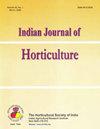通过氯代葡糖醇使微繁殖的互生木瓜离体生根
Q4 Agricultural and Biological Sciences
引用次数: 0
摘要
木瓜的微繁殖技术已在世界范围内得到优化。然而,目前仍缺乏经济可行的商业级木瓜标准快速繁殖技术。由于离体培养的建立相当容易,同时木瓜的离体生根仍然很困难。然而,离体生根成本高昂,而且离体生根没有侧枝和根毛,难以适应环境。因此,我们对微繁殖小植株进行了离体生根诱导和适应性培养。体外培养使用的是经过挑选的先进属间杂交种幼苗的嫩梢。将其接种到 Murashige 和 Skoog(MS)培养基 + 3% 蔗糖 + 1 µM BAP + 1 µM GA3 + 0.1 µM IAA + 0.25% phytagel 上,直到获得小植株。在离体生根方面,用不同浓度的氯代葡萄糖苷(PG)培养小植株,以研究生根的适宜条件。与离体生根相比,将木瓜小切口直接放入盆栽培养基(珍珠岩+蛭石+椰糠,比例为 1:1:2)中,然后浸入氯代葡萄糖苷(PG)中生根的效果更好(82%),并使小切口在适应环境过程中的存活率有所提高(82%)。在促进根系发育方面,1000 µM 的 PG 比 IBA 更有效。研究发现,小袋法最适合木瓜的离体生根和硬化,而且只需一步适应过程。本文章由计算机程序翻译,如有差异,请以英文原文为准。
Ex vitro rooting of micro-propagated intergeneric papaya through phloroglucinol
Micropropagation techniques of papaya have been optimized Worldwide. However, standard rapid multiplication technique of papaya at commercial level with economically viable is still lacking. Since establishment of in vitro culture pretty easy at the same time in vitro rooting of papaya is still difficult. However, in vitro rooting is costly and the roots initiated in vitro do not have lateral branches and root hairs, making them difficult to acclimatize. Hence ex vitro rooting induction of micro-propagated plantlets and acclimatization were conducted. In vitro cultures were established using shoot tips from seedlings of selected advanced intergeneric hybrid. They were inoculated onto Murashige and Skoog (MS) medium + 3% sucrose + 1 µM BAP + 1 µM GA3 + 0.1 µM IAA + 0.25% phytagel until plantlets were obtained. For ex vitro rooting, plantlets were cultured with various concentrations of phloroglucinol (PG) to investigate the appropriate condition of rooting. Direct rooting (82%) of papaya micro-cutting into potting medium (perlite + vermiculite + coco peat; in the ratio of 1:1:2) subsequent dipping into phloroglucinol was more effective than in vitro rooting and led to amended survival percentage (82%) of micro-cutting during acclimatization. PG at 1000 µM was extra effectual than IBA in encouraging root development. Sachet method was found to be the best appropriate for ex vitro rooting and hardening of papaya with single-step acclimatization.
求助全文
通过发布文献求助,成功后即可免费获取论文全文。
去求助
来源期刊

Indian Journal of Horticulture
农林科学-园艺
CiteScore
0.50
自引率
0.00%
发文量
22
审稿时长
4-8 weeks
期刊介绍:
Information not localized
 求助内容:
求助内容: 应助结果提醒方式:
应助结果提醒方式:


